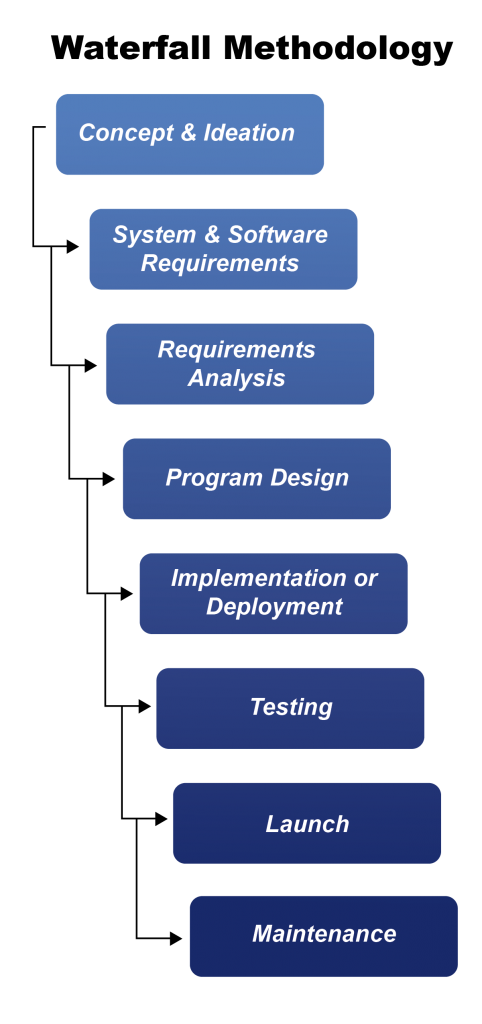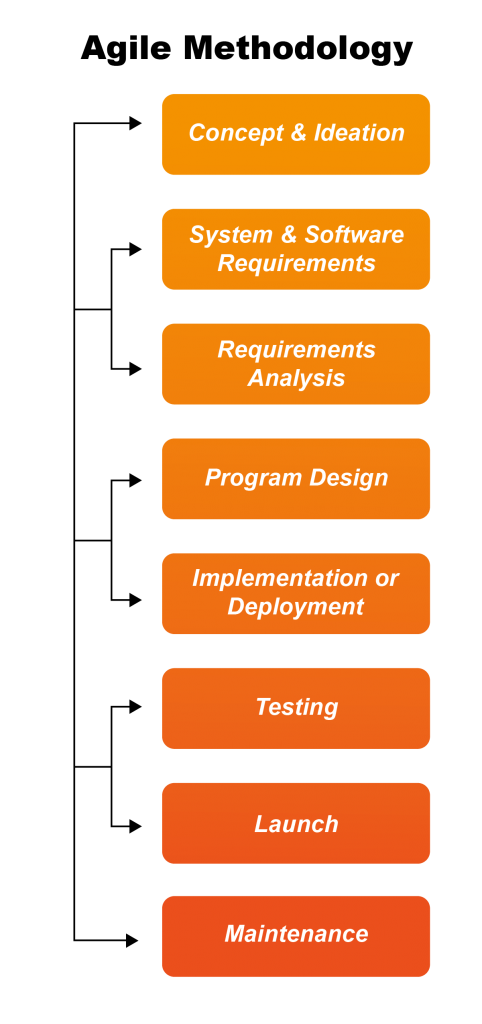Waterfall vs Agile Software Development
Comparing the Benefits and Challenges of Waterfall and Agile Software Development
December 8, 2020
Few things have had as much impact on business as software and application development. Almost every business uses or develops some form of software as part of its everyday operations. Software is so pervasive is has essentially become a necessary part of most business operations. In today’s fast-paced environment the idea of manually handling payroll, or typing out a document on a typewriter seems ridiculous. Everyday tasks like communicating online with your team, drafting a proposal, or managing business finances all depend on some form of software or application. These digital applications help us keep pace, automate, and do more in a day. They are integral to many industries and form the building blocks of many processes. It stands to reason that software development is a driving force behind much of the innovation taking place in the business world today. In this blog, we will peel back the curtain and take a look at two methodologies for software development.

What is Waterfall Development?
Waterfall development is about tackling a project sequentially and building upon the knowledge and work of the previous stage. It requires a clear plan and timeline. Waterfall development is ideal for larger projects with defined budgets. The waterfall method was developed in the field of engineering in a time before the internet. This method is generally considered to be outdated but is still effective for short, well-defined projects where the technology required is already well understood. The waterfall method of development typically looks a little like:
- Concept & Ideation
- System & Software Requirements
- Requirements Analysis
- Program Design
- Implementation or Deployment
- Testing
- Launch
- Maintenance
PROS
Clear, Orderly, & Well Planned
Both designers and customers have a clear understanding and are in agreement on what the end product will be
Easy to manage and control
Clearly defined stages mean that teams and resources can be easily allocated for set periods of time
CONS
Rigid, Slow, Low Visibility
Customers may struggle to define parameters for application because they cannot fully visualize it so far in advance
Changes are difficult and costly to make to previous stages
Lack of communication – each team is building on the work of a previous team but may not have direct access to them. Detailed notes may not be enough

What is Agile Development?
Agile development is an iterative strategy that focuses on communication and teamwork. Instead of creating linear schedules made up of specific tasks, development is divided into time-based “sprints”. Although agile development incorporates the same stages as waterfall development, it moves through them differently. The process is more fluid: each stage informs the one that comes before and after. Agile development is cyclical, allowing developers to go back to the drawing board, again and again, to make the product better.
Your team moves dynamically with agile development. Often rigid documentation is discarded in favor of a communicative customer-centric process. The ability to involve the customer more in development often leads to higher satisfaction with the end product. By prioritizing key functionalities and goals, agile development can build in deeper functionality through future iterations. The product delivers value more quickly than with the “all or nothing” waterfall approach.
Businesses are transitioning to agile development because it condenses the development process, increases transparency, and fosters innovation through teamwork. Your product remains more competitive when it can evolve to meet the needs of a fickle market.
PROS
Dynamic, Customer & Team Focused
- Faster Turnaround to meet customer demand
- Customer is highly involved and able to provide input at many stages within the development process
More flexible stages of development allow teams to give each other feedback and create a more cohesive product
All stages are testable and changes are easy to implement
CONS
Less Predictable, Easy to Lose Focus
It can be hard to define a concrete delivery date
Agile development teams tend to be small meaning that this method requires adaptable developers with a wide range of skills
Final product may be different than initial concepts and documentation is sometimes neglected
Some customers do not want to be constantly involved in the project
Which Method is Right for my Project?
An agile approach is generally agreed better when possible. The waterfall method still has its place, though, and may be deployed by less experienced teams who benefit from the structure. For small straightforward projects, the waterfall method may also suffice. Agile development requires an experienced and adaptive team that is comfortable working together. Complex projects that will require a great deal of testing greatly benefit from the back and forth process of agile development. It will help minimize bugs a launch to test throughout the process instead of just at the end.

Ian Checcio
Vice President of Federal and Healthcare Sector
“DOMA’s software development team has spent the last 20 years building a feature-rich Content Management SaaS platform. As our company has grown, DOMA has realized that the expansion of this team could provide a valuable resource to organizations outside of our own proprietary platform. We’re well-positioned to use that internal experience and expertise as an accelerator to reimagine existing applications or develop new solutions based on unique customer requirements.”
Ian Checcio
Vice President of Federal and Healthcare Sector
What Development Style Does DOMA Use?
DOMA employs an agile approach to software development that aims to ensure a high-quality product that fits the vision of our customers. Agile development is commonly divided into three styles- evolutionary, incremental, and iterative. DOMA employs an evolutionary model that maintains continuous feedback between each stage and the prior one. This model is used in an incremental, iterative way. Feedback is applied from the final stage back to the first stage resulting in each iteration producing a useable executable release of the software product.
In the incremental software process model: requirements are gathered in the initial stages after considering dependencies, user priorities, and the effort needed for each requirement; the system is divided into increments. Software engineering in the style of rapid iteration and incremental evolution focuses on the inevitability of constantly shifting system requirements, unforeseen situations of use and functional enhancement, and the need for developers to collaborate.
The Advantages of an Evolutionary model include:
- Marries the user experience with the various business and technical requirements of software development
- Software is continuously improving and expanding in scope, security, and quality
- Allows the team to more effectively collaborate and affect different stages of the project
- Adaptable to market demand ensuring a more user-focused product
About DOMA- Powered by Tech, Driven by People
DOMA Technologies (DOMA) is a software development and digital transformation company whose mission is to change customer lives by lightening their workload through faster and more targeted access to their data. Since 2000, our team of 200+ experts has helped businesses navigate all aspects of the digital world. We are a dedicated strategic partner for the federal government and private sector clients at every stage of their unique digital transformation journey.

Author:
Danielle Wethington
Director of Communications
DMT@DOMAonline.com
Digital Transformation
Learn more about DOMA’s Digital Transformation Solutions
Recent News
Learn More about DOMA’s Services:
Digital Solutions | Cloud Solutions | Hyper Automation | DX Software | Healthcare | Federal Government | SLED | Commercial





